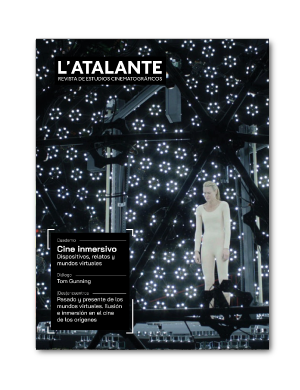Publicado 01.01.2023
Palabras clave
- Cine de los orígenes,
- Digital,
- Inmersión,
- Mundos virtuales,
- Simulación.
Cómo citar
Resumen
El presente artículo explora la relación entre el medio cinematográfico y la producción de mundos virtuales. A través de un análisis historiográfico, que toma como punto de partida los conceptos de «virtualidad» y de «series culturales», el siguiente texto propone analizar las estrategias inmersivas actuales del medio cinematográfico en vinculación con las del pasado. Así pues, esta perspectiva historiográfica nos lleva a señalar la presencia de determinadas prácticas pre-digitales que se fundamentan en la búsqueda de experiencias inmersivas. La hipótesis de partida es que la creación de mundos virtuales ya estaba presente en los orígenes del cine, que nació para expandirse más allá de sí mismo. En este sentido, el avance la tecnología digital ha servido para impulsar el desarrollo y la creación de estos mundos virtuales, a la vez que los ha vuelto más complejos al alterar la relación entre la imagen y su referente. El principal objetivo del texto es demostrar que, más allá de la revolución tecnológica habilitada por el avance del digital, resulta fundamental entender las implicaciones y el funcionamiento de los mundos virtuales del pasado para poder llegar a comprender las estrategias inmersivas de los mundos virtuales del presente.
Descargas
Citas
Barthes, R. (1989). La cámara lúcida. Nota sobre la fotografía. Barcelona: Paidós.<br>
Baudrillard, J. (1995). Le crime parfait. París: Galilée.<br>
Bazin, A. (1990). ¿Qué es el cine? Madrid: Rialp.<br>
Bonilla, D., Galán Fajardo, H. (2020). El cine sin encuadre: propuesta de Escala de Implicación Narrativa en Realidad Virtual. Anuario Electrónico De Estudios En Comunicación Social «Disertaciones», 13(2), 1-16. https://doi.org/10.12804/revistas.urosario.edu.co/disertaciones/a.8252 <br>
Català, J. M. (2005). La imagen compleja. La fenomenología de las imágenes en la era de la cultura visual. Barcelona: Servei de Publicacions de la UAB.<br>
Deleuze, G. (1968). Différence et Répétition. París: Presses Universitaires de France.<br>
Gaudreault, A. (2008). Cinéma et attraction. Pour une nouvelle histoire du cinématographe. París: CNRS.<br>
Lévy, P. (1995). Qu’est-ce que le virtuel? París: La Découverte.<br>
Manovich L. (2001). The Language of New Media. Cambridge Massachusetts: MIT Press. <br>
Quintana, À. (2011). Después del cine. Imagen y realidad en la era digital. Barcelona: Acantilado. <br>
Rodowick, D. N. (2007). The Virtual Life of Film. Cambridge: Harvard University Press. <br>
Virilio, P. (1988). La machine de vision. París: Galilée.</p>

